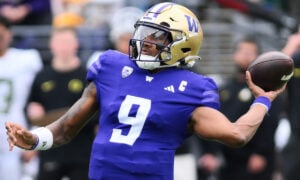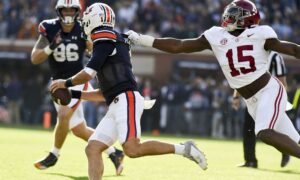Target Share Report: Week 14
Welcome back to the target share report, where we look at player usage and how it’s changed.
You can find all my 2020 data here.
You can also join my live stream every Monday (on Twitch, Youtube and Periscope) while I collect and discuss first impressions of each week’s stats.
I know there’s always a lot going on in my tables. I’m including information about the stats I utilize most at the end of the article if you’d like to know more about any of them.
This week I’ve compared target share over the last three weeks to their season-long percentage, to help identify those rising and falling in volume recently.
Enough preamble, nerd up!
Players Losing Volume

Injury Excused: Austin Hooper, Jonnu Smith
Travis Fulgham, WR PHI
Yeah, it’s not looking good for Fulgham – and not in the way the sun can occasionally blind you when you’re trying to catch a pass, apparently. He’s being drastically panned because of his fall over the last few weeks – almost like draft capital snobs just sullenly wait around hoping for any reason to discount the achievements of lower drafted players while making constant “wait and see” excuses for first-round picks.
BUT, since week nine, Fulgham hasn’t had a target share over 21% (he was averaging 25% in the weeks before) and over the last two weeks he hasn’t crested more than 8%. I’m holding in dynasty but he’s not a starter for your playoffs.
Adam Thielen, MIN WR
This should really be in the injury excuse section, but I want to point out that Thielen’s role hasn’t gone anywhere. In week 14 he had a low (11%) target share. But he’s only played two games in the last three weeks – because of their bye week – and in week 13 he had a 28% target share. It’s happenstance.
Jeff Smith, NYJ WR
Yeah, no one’s surprised. His larger target share for two games earlier in the season has disappeared.
AJ Green, CIN WR
He’s getting low-level distant WR3 volume, now without a decent quarterback to help move the value of the teams. His 4% target share in week 13 is dragging the average down, but I don’t think it signals a large or sustained drop in his role in 2020. It’s just also not a great role for fantasy at this point.
Larry Fitzgerald, ARI WR
Similar to Green, Fitzgerald’s role looks secure, his week 14 (9%) target share is making it look more drastic.
Players Gaining Volume

Discounted for low target share earlier in season: Luke Willson, Jacobi Meyers,
Marquise Brown, BAL WR
Baltimore now ranks dead last in passing attempts in 2020. Brown, in my opinion, continues to be underrated for the amount of – an admittedly very small pie – he’s creating. His 14 targets over the last two weeks have accounted for an average target share of 38%. That doesn’t make him startable in most leagues, but it does suggest his dynasty value could probably hold the potential for a top 24 season, at least, in his future. Hope springs eternal.
Cole Kmet, CHI TE
We covered this last week, but it continued in week 14.
Robert Woods, LAR WR
Since week 11, Woods has an average of 32% target share. It’s been a significant shift from a more even split with Cooper Kupp to a heavily lean towards Woods. Last week (8 PPR points) didn’t feel great. But over the last four weeks, he’s averaging 18 PPG. That’s top 12.
Collin Johnson, JAC WR
Whelp, that distant hope from the two weeks prior sure disappeared. The average of his last three weeks is still higher than his season-long average – obviously since he’d average 5% of targets week one to nine – but he really belongs in the “lost volume” section.
The return of Gardner Minshew drastically improved the level of play at the position but also reestablished the previous usage of the receivers. This could be good for DJ Chark, Laviska Shenault, and Keelan Cole, as you can see below. But Johnson may well be best left on the waiver wire now.

Michael Gallup, DAL WR
This is actually significant. Over the last few weeks, Gallup has reestablished a larger role on the offense. It’s mostly come at the expense of ancillary players like Cedrick Wilson, but CeeDee Lamb has also ceded some of his role over the last few weeks. Because of the value of those targets recently, however, it still a tough start as a borderline wide receiver two with a lower ceiling than we’re used to.

Andy Isabella, ARI WR
It’s only a two-week spike, but it’s noticeable that Christian Kirk has been struggling over the last few weeks. On the other hand, Isabella has risen to a 16% target share over the last two weeks. It’s hard not to see that Johnson, above, did the same thing and dropped immediately back down the next week. But Isabella was a higher drafted and more respected prospect as a whole. However, I do think it’s hard to expect much out of anyone except DeAndre Hopkins.
Well, that’s about all I have tome for this week. Hope you found some of it useful, interesting and entertaining. Be sure to let me know about it in the comments below or on Twitter, anytime.
Thanks again,
Peter Howard.
@pawhody
Addendum: The Stats explained
Real quick, here are the stats I’m using this week and what they are good for.
YD/TM Att: Yards per team pass attempt
This takes the Pass and Rush attempts of the player’s team each week and divides the player’s total yards against it. It’s a simple, yet powerful combination of efficiency and volume. It has a high R squared value in stickiness (it stays relatively consistent week over week and year over year).
It’s a good statistic to sort players by within a position.
PPG: PPR points per game
Fairly common stat that’s often undervalued these days. Depending on the sample, PPG is actually the stickiest and most accurate stat for predicting production.
EPG: Expected Points per game
This is based on rotoviz.com’s expected points formula (which I don’t know) but essentially measures how “valuable” the touches a player has received. It can be seen as a more accurate volume metric removing the player’s “efficiency” from the equation and just looking at how much value they are “given” by the team for fantasy points.
FPOE/G: Fantasy points over expected per game
Also a rotoviz stat, it gives us an idea of if a player is underperforming (negative number) or overperforming (positive number) their “given” volume. In other words, how efficient they have been.
TD Rate: Yards per Touchdown
Players typically average between 100 and 200 yards per touchdown. To be more accurate, if you’re like that, in 2020 (with more than 20 targets) wide receivers are averaging around 175 yards per touchdown, RBs are averaging 130 yards per touchdown, and tight ends are averaging 160.
Essentially, outside of this range, it tells us who may “regress” in touchdowns in the coming weeks.
Percentage of games with seven targets or more:
This one is fairly self-explanatory. I use it as a context check for target share. A high target share in a low passing offense isn’t as “good” as a lower target share in a high passing offense in terms of expected targets.
- Peter Howard: Dynasty Fantasy Football Superflex Rankings Explained - March 6, 2024
- Dynasty Target and Regression Trends: Week 15 - December 23, 2023
- Dynasty Target and Regression Trends: Week 14 - December 16, 2023


































































